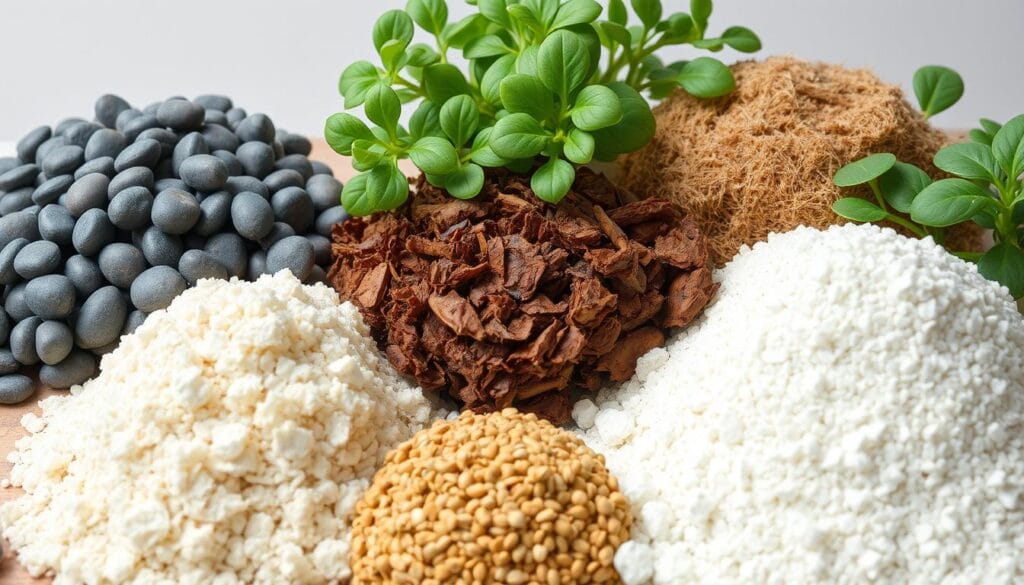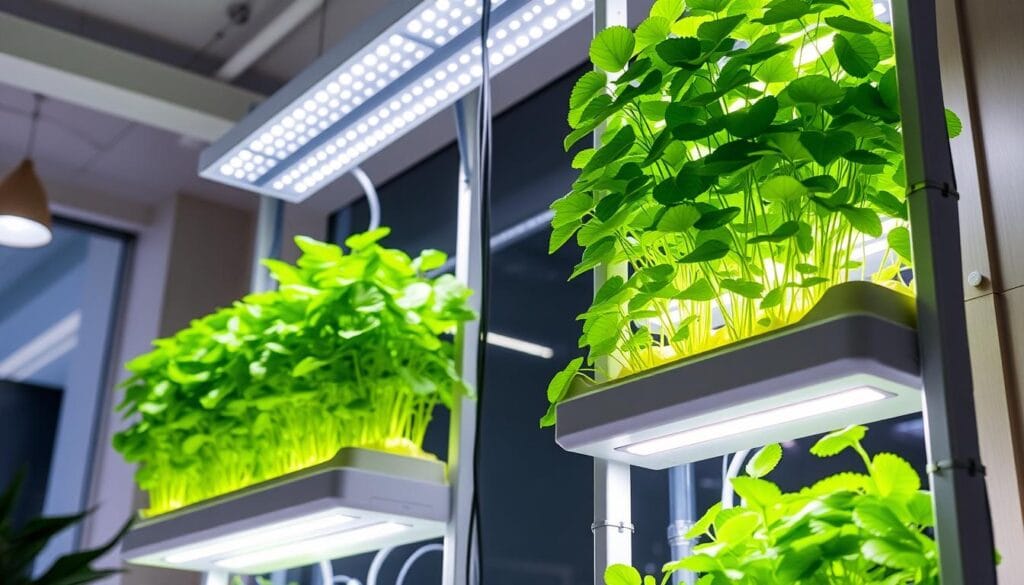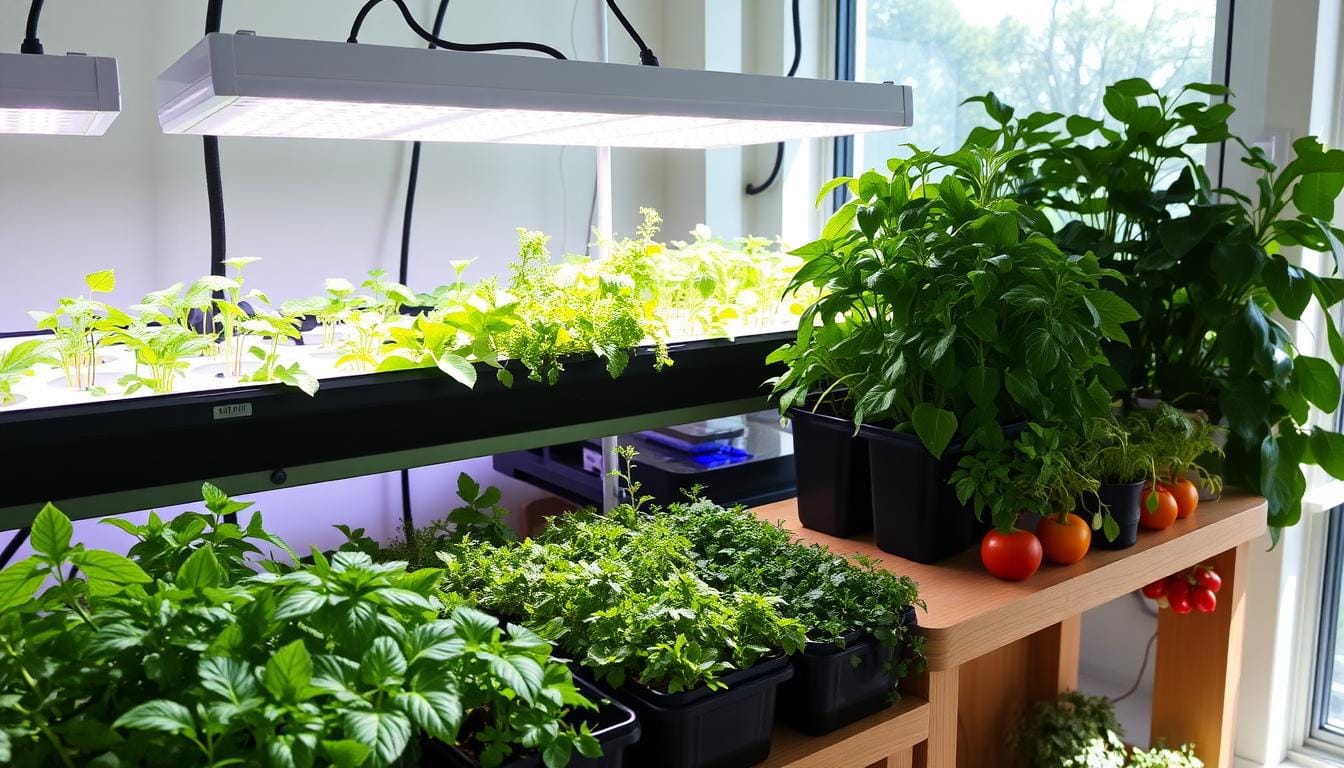Standing in my indoor hydroponic garden, I felt proud and accomplished. What was once empty now teemed with life. It showed the power of hydroponic gardening, changing how we grow food.
If you’re drawn to growing your food, you’re in the right spot. This guide will teach you DIY hydroponics. You’ll learn to grow food without soil, save space, and enjoy fresh produce all year.
Key Takeaways
- Discover the benefits of indoor hydroponic gardening, including increased productivity, space-saving solutions, and control over harvests.
- Learn to build efficient growing systems using 18 practical DIY projects suitable for beginners and experts.
- Explore the fundamentals of hydroponic gardening, including nutrient solutions, water management, and plant selection.
- Understand the essential components required for a successful DIY hydroponics setup, from lighting and temperature control to growing mediums.
- Dive into advanced system designs and upgrades to take your hydroponic journey to the next level.
Understanding Hydroponic Gardening Fundamentals
If you’re excited to dive into hydroponic gardening, knowing the basics is crucial. Hydroponics grows plants without soil, using a nutrient-rich water solution. This method is great for faster growth, saving space, and using less water.
What Makes Hydroponics Different
Hydroponics differs from traditional gardening because it doesn’t use soil. Instead, plants’ roots soak in a nutrient solution. This means plants get all they need from the water, not soil.
Benefits of Soilless Growing
- Higher yields and faster growth rates
- Efficient use of space, enabling you to grow more in a smaller area
- Reduced water consumption, as the nutrient solution is recirculated
- No soil-borne pests or weeds to worry about
- Ability to grow plants indoors, expanding your gardening options
Basic Growing Methods Overview
There are several hydroponic methods, each with its benefits. These include:
- Wick Systems: Great for beginners, wick systems use a passive method to feed the roots.
- Water Culture: Known as the “lettuce raft” system, it’s perfect for leafy greens.
- Ebb and Flow: This system floods and drains the growing medium, ideal for many plants.
- Nutrient Film Technique (NFT): Plants’ roots are constantly fed by a flowing nutrient solution.
- Aeroponics: The most advanced, it sprays a fine nutrient solution on the roots.
Essential Components for Your DIY Hydroponics Setup
Starting a DIY hydroponic project means picking the right parts for a system that works well. At the core of any good hydroponic equipment setup are a few key pieces. These pieces work together to give plants the best conditions to grow.
Your DIY hydroponics system starts with a strong container or reservoir for nutrient-rich water. You’ll also need a grow tray for your plants and their growing mediums like net pots, clay pebbles, or coco coir. An air pump and air stone are key for adding oxygen to the water and helping roots grow well.
For moving water around, you might need a water pump, but some systems like the Kratky method use gravity. To give plants enough light, especially indoors, good grow lights, like LED bulbs, are a smart choice.
It’s also important to have the right nutrients and a way to check the water’s pH level. Optional extras include a timer for lighting and a thermometer to keep an eye on temperature and humidity.
Knowing how these parts work together is important for both new and experienced hydroponic gardeners. By choosing and using these key elements well, you can make a DIY hydroponic system that thrives. This system can grow many types of plants, even in small spaces.
“
Hydroponics is a method of growing plants without soil, relying solely on water and nutrient-rich solutions. It’s a great option for small spaces and can lead to faster growth and higher yields.”
| Component | Purpose |
|---|---|
| Container/Reservoir | Holds the nutrient-rich water |
| Grow Tray | Supports the plants and growing medium |
| Net Pots | Holds the growing medium and plant roots |
| Air Pump and Air Stone | Oxygenates the water for healthy root development |
| Water Pump (optional) | Circulates the water in the system |
| Grow Lights | Provides the necessary light energy for plant growth |
| Hydroponic Nutrients | Supplies the essential nutrients for plant nourishment |
| pH Testing Kit | Ensures the water’s pH level is optimal for plant growth |
| Timer (optional) | Automates the lighting schedule for the grow lights |
| Thermometer (optional) | Monitors the temperature and humidity levels in the system |
Selecting the Perfect Location and Environment
Choosing the right spot for your gardening, vertical farming, and urban farming is key. It affects how well your hydroponic setup does. You need to think about light, temperature, and humidity.
Light Requirements and Solutions
Plants need lots of light, about 12-18 hours a day. If you can’t get natural sunlight, LED grow lights are a good choice. They provide plants with the essential light required for healthy growth.
Temperature and Humidity Control
The ideal temperature for most plants ranges from 65 to 75°F (18 to 24°C). Keeping this temperature helps plants grow strong. Also, keeping humidity between 40-60% stops mold and fungi from growing.
Space Planning and Management
Plan your hydroponic system’s layout carefully. Use vertical farming to save space, especially in cities. Make sure you can easily get to your plants for care and harvesting.
| Environmental Factor | Optimal Range | Importance |
|---|---|---|
| Light | 12-18 hours daily | Crucial for photosynthesis and plant growth |
| Temperature | 65-75°F (18-24°C) | Affects plant metabolism and nutrient uptake |
| Humidity | 40-60% | Prevents mold, mildew, and fungal growth |
By picking the right spot and creating a great growing space, you’re ready for success in indoor gardening, vertical farming, or urban farming.
Nutrient Solutions and Water Management
Keeping your hydroponic garden healthy means having the right nutrient solution. This solution has macronutrients like nitrogen, phosphorus, and potassium. It also has micronutrients like calcium and iron. The best mix of nutrients changes based on the plants you grow and their growth stage.
It’s important to mix and check your nutrient solution often. Stick to the recipes and guidelines to give your plants the nutrients they need. Make sure the pH is between 5.5-6.5 and the electrical conductivity (EC) is right for your plants to absorb nutrients well.
Using clean, good-quality water is key for your hydroponic system. Keep nutrient solutions clean to avoid contamination. Also, flush your system now and then to stop salt buildup and nutrient lockout. Using smart water management tools can help your plants get the nutrients they need for growth.
| Nutrient | Optimal pH Range | Ideal Concentration |
|---|---|---|
| Nitrogen (N) | 6.0-7.0 | 50-200 ppm |
| Phosphorus (P) | 6.5-7.5 | 30-80 ppm |
| Potassium (K) | 5.5-7.5 | 100-300 ppm |
Understanding nutrient management and maintaining water quality are essential. It helps your hydroponic plants grow well and reach their best.
Best Plants for Hydroponic Success
Choosing the right plants is key to a successful hydroponic garden. You can grow everything from leafy greens to juicy fruits without soil. Let’s look at the top picks for your hydroponic setup.
Leafy Greens and Herbs
Leafy greens like lettuce, spinach, and kale are great for hydroponics. They grow fast in nutrient-rich water, ready in 25-60 days. Herbs like basil, parsley, and cilantro also do well, as they can be picked over and over again.
Fruiting Plants
Don’t stop at just greens and herbs. Tomatoes, strawberries, and peppers are also great for hydroponics. They might take longer, 75-90 days, but the taste of homegrown produce is worth it.
Growth Timelines and Expectations
When planning your hydroponic garden, think about how long each plant takes to grow. Leafy greens and herbs grow fast, in 30-75 days. But, fruiting plants like tomatoes and peppers need 75-90 days. Mixing fast-growing and slower plants ensures a steady supply of fresh produce.
“Proper plant selection ensures a constant supply of fresh, healthy produce from your hydroponic garden.”
Growing Medium Selection and Preparation
Choosing the right growing medium is key to your hydroponic garden’s success. You can use rock wool, perlite, vermiculite, coconut coir, or clay pebbles. Each has its benefits for water, air, and pH levels. Think about what your plants need.
Preparing your growing medium is crucial. For example, rockwool cubes need soaking in pH-balanced water. This adjusts the pH and hydrates them. Other media, like coconut coir, might need rinsing to remove salts. Proper preparation helps your plants grow well.
| Growing Medium | Water Retention | Aeration | pH Neutrality | Reusability |
|---|---|---|---|---|
| Rockwool | High | Moderate | Neutral | Limited |
| Perlite | Low | High | Neutral | Reusable |
| Vermiculite | High | Moderate | Neutral | Reusable |
| Coconut Coir | High | Moderate | Neutral | Reusable |
| Clay Pebbles | Low | High | Neutral | Reusable |
Think about water, air, pH, and if it can be reused when picking a medium. Good preparation means a healthy place for your plants to grow.

Building Your First Wick System Project
Embarking on your hydroponic gardening journey can be both exciting and rewarding, particularly for beginners. The DIY wick system is a great place to begin. It uses capillary action to feed nutrients to plant roots. This makes it easy and low-maintenance for beginners.
Materials and Tools Needed
To start your wick system, you’ll need some basic items and tools:
- A container or grow tray (like a 5-gallon bucket or storage bin)
- A reservoir for the nutrient solution
- Wicks made from cotton, nylon, or propylene
- A growing medium like coco coir, perlite, or vermiculite
- Your chosen plants, such as herbs, leafy greens, or small vegetables
- Drill and drill bits
- Scissors or utility knife
Step-by-Step Assembly Guide
Here’s how to set up your DIY wick system:
- Drill holes in the container or grow tray for the wicks.
- Cut the wicks to the right length, reaching from the reservoir to the growing medium.
- Put the wicks through the holes, making sure they hang down into the reservoir.
- Fill the container with your chosen growing medium, leaving space at the top for plants.
- Plant your seedlings or cuttings in the growing medium, spacing them as needed.
- Add water and nutrient solution to the reservoir, making sure the wicks are fully submerged.
Maintenance Tips
To keep your DIY wick system healthy, follow these tips:
- Check the nutrient solution levels in the reservoir and refill as needed.
- Prevent algae growth by shielding the reservoir from light with a cover or opaque container.
- Look for salt buildup on the wicks and growing medium, and flush the system periodically.
- Adjust the nutrient solution strength as your plants grow and their needs change.
By following these steps, you can easily set up a DIY wick system. It’s a great way to start your hydroponic journey. The wick system is a simple and budget-friendly choice, perfect for beginners.
Advanced System Designs and Upgrades
As you get better at hydroponic gardening, you might want to try more advanced systems. These include nutrient film technique (NFT), deep water culture (DWC), and aeroponic systems. They make your gardening more efficient and give you better control.
Another great upgrade is hydroponic automation. This can include systems for automatic nutrient dosing and climate control. It even includes vertical growing structures. These features can greatly increase your yields and let you grow more types of plants.
When picking a new hydroponic system, think about your space, budget, and the plants you want to grow. Vertical hydroponic systems save space, while NFT systems keep the roots constantly nourished.
“Hydra Unlimited’s RDWC system delivered fast growth and outstanding results. It’s the best company I’ve worked with for hydroponics.”

Using advanced hydroponic techniques and customizing your setup can open up new possibilities. Whether you’re growing greens, fruits, or many different crops, these upgrades can help you reach your goals more efficiently and accurately.
Troubleshooting Common Hydroponic Problems
Keeping your hydroponic garden healthy means watching out for common problems. Issues like nutrient deficiencies, pH imbalances, and root rot can slow down plant growth. It’s important to check your system often and fix problems quickly.
Nutrient deficiencies are a big issue in hydroponics. Signs include yellow leaves, slow growth, and odd leaf shapes. Testing the pH and electrical conductivity (EC) of your nutrient solution regularly is key. This ensures your plants get the right mix of minerals.
pH imbalance is another common problem. pH levels can change quickly in a hydroponic system. This affects how plants absorb nutrients. It’s crucial to test pH levels often and adjust the nutrient solution as needed.
Root rot is a major issue too. It’s caused by too much water, poor air, or pathogens. Check your plant roots often and make sure your system has good drainage and air. This helps prevent and treat root rot.
Being quick to spot and solve problems is key to a successful hydroponic garden. By staying alert and acting fast, you can keep your garden healthy and productive.
| Common Hydroponic Issues | Causes | Solutions |
|---|---|---|
| Nutrient Deficiencies | Imbalance in nutrient solution | Test pH and EC levels, and adjust nutrient mix accordingly |
| pH Imbalance | Fluctuations in pH due to various factors | Regularly test and adjust the pH of the nutrient solution |
| Root Rot | Overwatering, poor aeration, pathogen buildup | Improve drainage, increase oxygenation, and monitor root health |
| Algae Growth | Exposure to direct sunlight, nutrient solution issues | Keep the system away from sunlight, change nutrient solution regularly |
| Pests and Diseases | Lack of hygiene, introduction of harmful organisms | Regularly inspect for pests, introduce beneficial insects, maintain cleanliness |
By being proactive and solving problems quickly, your hydroponic garden will thrive. Regular checks, system upkeep, and quick fixes are essential for success.
Conclusion: Taking Your Hydroponic Journey Forward
Exploring hydroponic mastery has opened doors to growing plants all year, saving water, and getting great yields. Your path from newbie to pro has been full of trying new things, solving problems, and loving the green side of indoor farming.
Keep exploring and improving your hydroponic mastery. Try out different systems like Ebb and Flow or Deep Water Culture. See which plants do best in your setup. Also, keep up with new hydroponic tech, like energy-saving LED lights and ways to use less water.
See the value of sustainable gardening and how your hydroponic work can help cities. As you get better and learn more, share your stories with others. This will inspire new indoor farmers. Your journey in hydroponics is ongoing, and with hard work, your indoor garden will keep growing and thriving.

